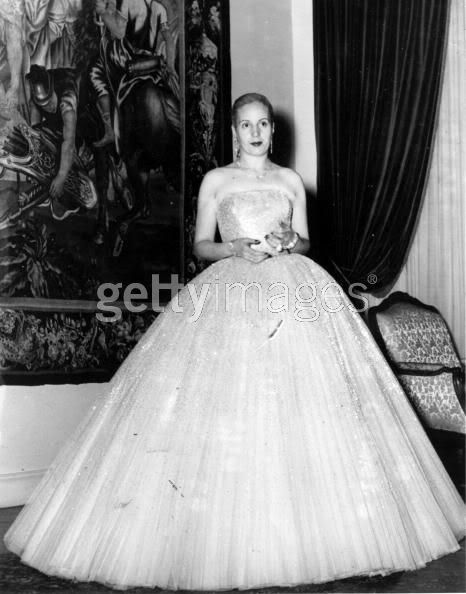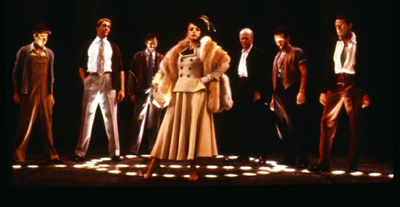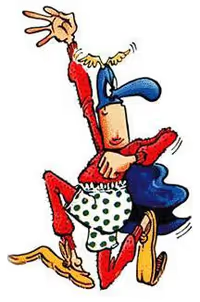"Buenos Aires" Lyric Question
Gaveston2
Broadway Legend Joined: 6/28/11
#25Buenos Aires lyrics question
Posted: 2/13/12 at 3:08pm
I think Michael Bennett is absolutely right about the allegorical nature of the original material. (It was that quality which made occasional biographical details such as Che's complaints about his insecticide stand out like sore thumbs.)
But Peron had only been dead a few years and his associates and supporters were still major players in Argentinian politics. His second wife was just finishing her presidency when the concept album was released. And of course Che Guevara was still an admired figure, not only in Argentina and Cuba, but anywhere Latin Americans were struggling against oligarchs.
So treating these people as if they were mythical figures such as Joseph, Jesus and Judas was always a little unsettling. (For those who believe Jesus was an historical person and the Son of God, fine. Here, I'm only speaking of his appearance in Rice's allegory.)
I think we would have seen more protests of Rice's treatment of real Argentinos if England or the U.S. had larger Argentinian exile populations, just as Mexican-Americans were beginning to complain strongly about the way their historical figures, such as Pancho Villla, were portrayed in Anglo projects.
There is a fair ethical issue IMO concerning the tradition of First World artists simply using Third World historical figures as fodder for stories the First World wants to tell itself. It's a form of cultural theft and reduces important Third World figures to mere literary and dramatic devices. Unfortunately, the critical discussion when EVITA opened tended to center on whether Fascists were being glorified because Eva had nice outfits and big numbers, a much more superficial view of the issues that arise from Rise's treatment.
Don't get me wrong: I've grown as fond of the score as anyone. But ethically, Rice might have been better off inventing allegorical characters rather than appropriating them so casually from another culture.
ETA giving the Perons realistic sets does not solve this issue. If anything, it makes the problem worse.
ETA2 I don't mean this to be a blanket condemnation of Tim Rice. I admire much of his work and EVITA is my favorite of his librettos. The issue of cultural appropriation was in its early discussions, mostly in academia, when he wrote EVITA, and as has been discussed here, he certainly worked hard not to reduce Eva Peron to easy conclusions like "good" or "bad"--and for that he deserves much credit.
Updated On: 2/13/12 at 03:08 PM
#26Buenos Aires lyrics question
Posted: 2/13/12 at 3:51pm
Unfortunately, the critical discussion when EVITA opened tended to center on whether Fascists were being glorified because Eva had nice outfits and big numbers, a much more superficial view of the issues that arise from Rise's treatment.
The glamour aspect was heightened in the staging and costumes, but I felt it was justified for very specific reasons. One of the biggest items in contention was the famous Don't Cry for Me dress which was far more opulent than anything shown in the photographic history of Eva. But I thought it was used wisely to create the dramatic dichotomy of the scene. Had she been seen in one of her more conservative looks that was a literal representation, it may have appeared glamorous to those people in that time, but it would not have the same effect when trying to convey the sense of hypocrisy on stage to modern audiences, especially when telling the biography of a controversial pseudo-political figure that simply was not as well-known to the pre-internet American and British public at the time.
The only character I felt was treated as "mythical" was Che simply because he was costumed to represent Guevara, yet the show relied heavily on the assumption that the audience specifically knew Guevara's politics and story (rather than simply being a cool graphic logo design). He represents the voice of dissent from the very beginning, so the idea that Fascists are glorified based on glamour or spectacle only illustrates the superficial view of the critic rather than any fault in the staging. The idea of removing the Guevara element and using him as an Everyman devil's advocate is fine with me since we are never presented with the Guevara story (nor is it necessary). But I don't feel like Eva or Juan are presented as mythical at all. Summarized, but not to a highly fictional extent.
When telling a biographical story, there will always critics who question the accuracy, the angle and the quantity of facts. Hell, even in fictional stories this occurs. How many times have we heard that Rent wasn't "gritty" enough by those who remember the East Village from that period? Well, what WOULD be gritty enough? How far do you have to go? Or in this case, how much are you expected to tell and how detailed? Webber and Rice didn't want to paint by the numbers and the score reflects that. So why stage it in the most conventional way possible? The score is not a literal representation of the place and time and I don't think it should be. Literal staging takes the show in the opposite direction of its purpose.
#27Buenos Aires lyrics question
Posted: 2/13/12 at 4:32pm
I find it interesting that in the last few years we've seen very 'realistic' revivals of musicals like FOLLIES, EVITA and even CARRIE that in their original incarnations were given highly abstract stagings. I think in most of these instances the justifications given by the creative team have been something along the lines of feeling that realism is more synonymous with human truth (i.e. the drama of 'real, 'humanized' characters is somehow exposed when the theatricality is stripped away) when I think in a lot of instances the reverse is true.
But interesting to see that trend - you would think it might be the reverse, but much of the commercial theatre in the 70s and 80s was a lot more daring and leading edge conceptually and directorially that whats on Broadway now.
But I think that tends to be cyclical to some degree. I mean look at CABARET - which over the years has become so gritty and dark and 'realistic' that the most shocking (and illuminating) thing you could probably do with the material now is to go back to staging it how it was in 1966.
Updated On: 2/13/12 at 04:32 PM
Gaveston2
Broadway Legend Joined: 6/28/11
#28Buenos Aires lyrics question
Posted: 2/13/12 at 9:37pm
I couldn't agree more, Michael. Realism (and naturalism) are based on the idea that truth is best revealed by careful attention to accurate, outer details of behavior, speech, dress, etc. The shows you mention take an entirely different approach, revealing "inner" truth through allegorical devices. As you say, I'm sure the trend toward realism is cyclical, but that doesn't mean using it displays every show in the best light.
***
Mister Matt, to me--in the 1970s and now--I think it's very important to remember that Fascism IS terribly attractive: exciting and glamorous. That's why it's so dangerous. Democracy, on the other hand, may offer a few heady moments, but tends to be messy and boring over the long haul.
#29Buenos Aires lyrics question
Posted: 2/13/12 at 9:50pm
"I don't want realism. I want magic! Yes, yes, magic."
--Blanche DuBois
#30Buenos Aires lyrics question
Posted: 2/13/12 at 10:48pm
"One of the biggest items in contention was the famous Don't Cry for Me dress which was far more opulent than anything shown in the photographic history of Eva. But I thought it was used wisely to create the dramatic dichotomy of the scene. Had she been seen in one of her more conservative looks that was a literal representation, it may have appeared glamorous to those people in that time, but it would not have the same effect when trying to convey the sense of hypocrisy on stage to modern audiences, especially when telling the biography of a controversial pseudo-political figure that simply was not as well-known to the pre-internet American and British public at the time."
First of all, Eva Peron was not a pseudo politician. True, she didn't hold an official post, but she wielded real political power and influence. She took over all the duties of vice-president (except military) and founded the Peronista Feminist Party after women won the vote on her watch. Also, for the first time in Argentina, women were being elected to mayoral/gubernatorial posts. All Peronists, of course.
Secondly, Eva did initially flaunt her newly-acquired wealth. She showcased her diamonds and furs and elaborate hairdos at every public function. Heck, her so-called Rainbow Tour was one big publicity stunt, and she was ridiculed in the press abroad for it. She was accused of impersonating a Hollywood movie star than behaving like a respectable president's wife. But after her return, she toned things down, choosing to wear simple tailor suits, little makeup, and her hair in the now-famous chignon. However, she still dressed up on formal occasions. In fact, that famous white ballgown in Prince's production is based on an actual Dior gown she wore to the Teatro Colon in 1951 (seen here).

Another dress worn by Eva made it into the original production, as well. Patti/Elaine wore it during "Rainbow High."



You can see the actual outfit/hat (minus the stole) here at 6:02.
http://www.youtube.com/watch?v=5wLMcxyOSsU
Vita, dulcedo, et spes nostra
Salve, Salve Regina
Ad te clamamus exsules filii Eva
Ad te suspiramus, gementes et flentes
O clemens O pia
#31Buenos Aires lyrics question
Posted: 2/14/12 at 12:54am
Michael B said: "I find it interesting that in the last few years we've seen very 'realistic' revivals of musicals like FOLLIES, EVITA and even CARRIE that in their original incarnations were given highly abstract stagings. I think in most of these instances the justifications given by the creative team have been something along the lines of feeling that realism is more synonymous with human truth (i.e. the drama of 'real, 'humanized' characters is somehow exposed when the theatricality is stripped away) when I think in a lot of instances the reverse is true."
Is this a trend in general? I think one fault with so many of the Tennessee Williams revivals as of late that haven't worked is they don't seem to realize how much he didn't want his productions to be realistic (something Elia Kazan agreed with--I already can only imagine what the revival of Sweet Bird of Youth might be like if it ever actually gets off its feet--a play that is particularly impossible to make work in a realistic style, yet I've seen many try just that--). Williams himself said that plays like Glass Menagerie are hopelessly maudlin and sentimental if you do them realistically.
At any rate, this is something Prince got with Evita, and I agree that, as well received as it was by critics it seems in general, the Evita staging doesn't work when it's made more realistic, at least in a theatrical concept. (It doesn't btoher me as much for the movie for a variety of reasons, though I do find the movie flawed).
I think it's spot on that there tends to be a feeling lately that "more authentic/gritty/honest=more realistic/literal". I wouldn't call Mendes/Marshall's Cabaret staging realistic, but evern there there is something to be said.
Oh, but I still hate the BA lyric--but it's partly as I think it's incoherent toanyone first hearing it in the theatre (and that's more due to the "I want to be a/part of BA" line than Big Apple.
#32Buenos Aires lyrics question
Posted: 2/14/12 at 1:55am
SM2 beat me to the punch with the GIANT WHITE DRESS picture, which shows that the Don't Cry For Me dress is rooted in historical accuracy, but what's not shown is that this was kinda modest for Eva when it came to couture and State functions. There were far more elaborate get-ups, but the big white dress is the one that became iconic.
(I don't know jack about women in Argentine politics of the 1940s, so I won't even try to comment on that.)
#33Buenos Aires lyrics question
Posted: 2/14/12 at 10:38amI totally forgot about that photo! My bad. But I do remember that dress being a controversial issue in the original production. Perhaps it was because she didn't wear it for speechifyin' or something.
#34Buenos Aires lyrics question
Posted: 2/14/12 at 11:14am
It was a very strong statement on Harold Prince's part to put the character in the now infamous white dress for the Don't Cry for Me Argentina number. Eva Peron never wore anything like that when she spoke to the public, but Prince wanted the moment for the character to not only be a Cinderella moment but a sort of convoluted expression of her hypocritical narcissism -- as if to say when she speaks "I've taken these riches only for YOU. For all of you..." that what she also means is "but I will relish wearing these myself in the mean time..."
Remember that the original production was very anti-Peron. That dress was supposed to feel slightly grotesque and it did.
Given the sympathizing of the character in this staging its a little odd that they still put her in the dress (though the layers to the skirt are indeed more modest this time).
Gaveston2
Broadway Legend Joined: 6/28/11
#35Buenos Aires lyrics question
Posted: 2/14/12 at 4:09pm
I foolishly watched the Russell Crowe ROBIN HOOD last night and was reminded of how the movies have treated history since at least BRAVEHEART: careful, even obsessive, attention to exterior details of dress and decor, all the while the script completely ignores the historical, political, economic and social realities of the era dramatized. Such films offer "truth" only in the most shallow sense.
Since movies have tended to be the dominant art form of the last century, is it possible they have inspired a trend toward superficial realism in musical theater?
#36Buenos Aires lyrics question
Posted: 2/14/12 at 4:44pm
I can't agree strongly enough with Mister Matt, Michael Bennett, Gaveston 2, Eric, and basically everyone discussing the original production of Evita. Y'all give me hope that there are people who still get it and actually enjoy looking beyond the obvious. We need to shoo this lame "realism" away from the stage. It has no business tainting what has always been a very unique art form that can reach us in remarkable ways be it through a well crafted lyric, a strategically lit symbolic structure or illusion, choreography that at once entertains and tells stories of its own, and so much more. Prince understands this unique theatricality, but nowadays, it is being used to promote "realism" and watered down revivals with "re-inmagined" orchestrations, and it is done by simply calling the stunning achievements of older theatrical works "dated" "dishonest" "unrealistic" and "unexciting" and the new hack jobs are suddenly modern and relevant, therefore better. Nuh Uh.
The original Evita also had wit that I saw no trace of in the revival that is so real and takes itself so seriously. I'd say the original is far more respectful to the real Eva, in that it doesn't pretend to BE her life. It merely interprets it and leaves us to our own devices.
Videos





